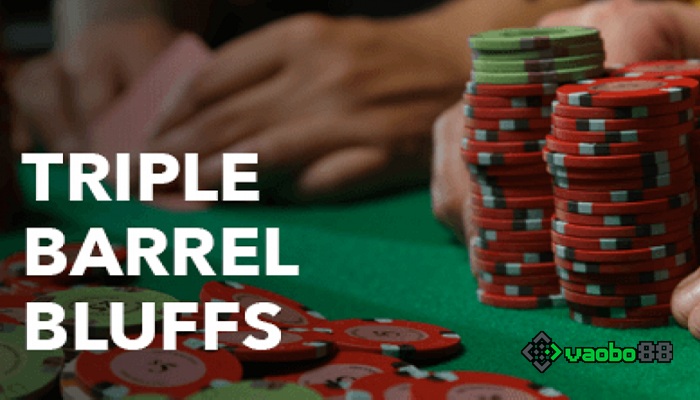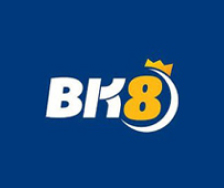Triple Barrel Poker is poker terminology referring to the act of betting consecutively in 3 stages when playing the game of Texas Hold’em, causing opponents to feel “dizzy” and fearful.
In reality, this is not a simple tactic but rather a very complex one, requiring players to have a lot of experience as well as special skills.
If you are struggling and do not know how to handle the 3-stage betting situation safely and reasonably, do not miss the following useful tips.
What is Triple Barrel Poker?
Triple Barrel Poker is understood as the act of a player consecutively betting 3 large stages with a huge bet amount, causing opponents to be astonished.
Specifically, the betting process starts from the flop and ends at the river with increasingly high raises, demonstrating the player’s strength and determination to go all in.
At the flop, you have decided to act by using a very high c-bet, but the opponent is too stubborn and continues to call or even raise back.
Therefore, the player continues to bet another significant amount at the turn, hoping the opponent will know when to back down. This tactic is called a double barrel.

However, if that “crazy” bettor continues to call, what you need to do is to raise again by 2x, or even 3x, or go all in at the river.
The series of 3 consecutive bets that keep increasing is called Triple Barrel in Poker.
Most of the time, this betting style will help players win a large amount or bluff in Poker against opponents; however, it also creates some of the biggest betting losses in Poker history.
Effective ways to counter Poker Triple Barrel
From the definition and method of executing 3-stage betting, you must have somewhat understood the consequences of it for other players.
So, is there a way to counter Triple Barrel? For beginners or those without much experience facing this situation, it seems like a total loss.
However, experts have researched and successfully developed 3 effective tactics to counter Triple Barrel in Texas Hold’em, including:
1. Carefully calculate your call range
Knowing yourself and knowing your opponent will lead to victory in every battle is never a wrong saying when you are forced to compete with others.
In Poker, it is the same; to counter every situation, the first thing a player needs to do is calculate their own call range along with that of other players.
You must understand what the opponent’s habits are and how much money you have to follow in the betting round.
When facing a maniac player, calling more than usual will yield good results.
Conversely, when playing against a passive opponent, you should fold more often.
In cases where the players are evenly matched, making it difficult for you to predict their habits, estimating your call range and then building your play based on that will be reasonable.
2. Control your fear
Most players tend to feel scared when an opponent raises 3 times and cannot place a call. In fact, if you understand the situation well, you have the opportunity to control your psychology, calculate scientifically, and make a decision.
To make it easier to understand, follow the example below:
Betting table 0.5$/1$ 6 with a stack of $100
Hero in BB => 3 players fold => BU raises $2.5 => Hero calls.
Flop ($5.5) has Q♥ 9♠ 7♠
Hero checks => BU bets $8.4 => Hero calls
Turn ($12.70) has 5♥
Hero checks => BU bets $8.4 => Hero calls
River ($29.50) has 4♣
Hero checks => BU bets $19.5 => What should Hero do?
In fact, when Hero continues to call according to the previous rounds, the EV index increases significantly, indicating that Hero is at a great advantage and ready to reap a huge reward.
EV Component Analysis
To analyze the above situation more thoroughly, you just need to consider two options:
1. Hero checks + opponent bets
These are two hypotheses representing the EV of situation 1 when Hero checks while the opponent bets. In the first simulation, the player is at GTO against GTO, and the second is when BU does not use a bluff.
According to the calculations, we have a total EV of 55.21 in GTO play.
Conversely, the total EV is -8.43 in BU play without bluffing.
Thus, Hero will lose money in this case.
2. Hero checks + opponent checks
Similarly, we have the first part as GTO against GTO and the second part as BU not using a bluff.
Thus, the total EV of GTO is 242.69.
Meanwhile, the total EV of BU without bluffing is 254.36.
Therefore, even checking back without bluffing is still a favorable situation.
Opponent checking back without bluffing increases EV
From the two situations above, it can be confirmed that if you catch a bluff and fold, you can completely play against a player with a bluff hand when they do not bet 3 times.
Even if you call when facing a NIT, the chance of winning is even higher than against a bluff player in this situation.
This is also the reason why players do not need to worry or fear anything.
To increase EV when the opponent plays NIT, you just need to call down frequently.
3. Accurately calculate the call down range
There are 4 factors that affect your call down range when playing Poker, including:
- Size of cbet
- Strength of the hand
- Blocker
- Opponent’s playing style
To clarify, let’s look at the following case:
- 6 players playing Poker $0.5/$1 with a stack of $100
- Hero in BB => 3 players fold => BU raises to $2.5 => SB folds => Hero calls.
- Flop ($5.5) has Q♥ 9♠ 7♠
- Hero checks => BU bets $8.4 => Hero calls
- Turn ($12.70) has 5♥
- Hero checks => BU bets $8.4 => Hero calls
- River ($29.50) has corresponding hands for each example.
Example 1: River 2 ♣️
In case 1, the river has 2 ♣️, you are encouraged to call down about 55.55% of your total range.
Accordingly, the solver calls in most high pairs and stronger hands.
However, you cannot play with the complex frequency of a real solver and need to simplify them. Specifically, you call with all top pairs, second pairs, and top kickers.
Example 2: River flush 2 ♠
This is a card that can improve some hands in your range, meaning that a top pair makes the opponent weaker.
The solver folds most off-suit top pairs that cannot lock a flush and nearly half of suited top pairs that do not create another flush.
If you have a second pair that locks a flush, you can still call.
Example 3: River straight 6 ♦️
The river straight 6 ♦️ is a relatively difficult case for players with many complex frequencies.
You can choose to play solver calls with pairs like top pair, second pair, or even fold intermittently in a few rounds.
When playing in a simpler way, you only need to call if you encounter any top pair that cannot lock the opponent’s flush hand.
Example 4: River overcard K ♣️
Finally, with the overcard K ♣️ situation, the player’s range has upgraded to a stronger top pair, creating opportunities to fold weak hands like second pairs.
The solver should only call hands from top pairs upwards with some mid pairs that can lock a straight.
See more tips – other Poker betting terms:
- C Bet in Poker is what? Practical examples & How to apply effectively
- Downswing Poker is what? How to handle the Downswing phenomenon
Conclusion
Triple Barrel Poker can be seen as a powerful move that puts players in a difficult situation, unable to continue but not wanting to stop.
Depending on the strength of the hand you hold, the actions in this case will change, so players should not be subjective and should remember the 3 tricks to counter barrels in the following article before placing bets on reputable online Poker sites.








